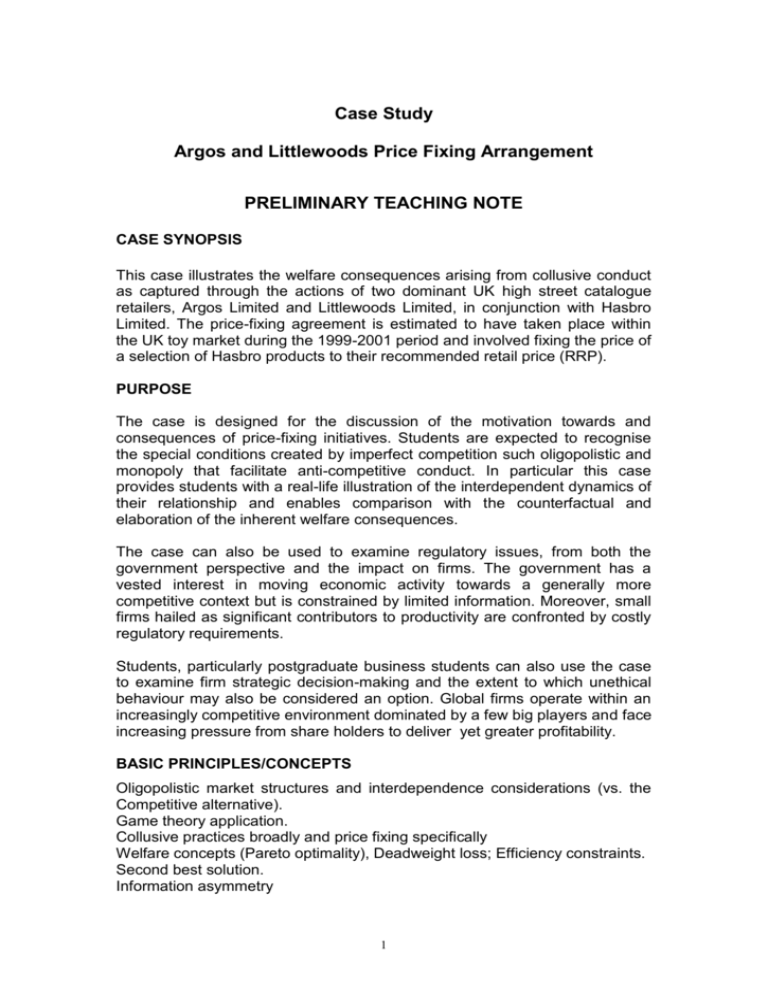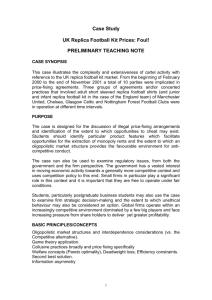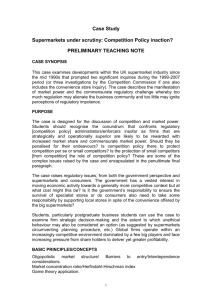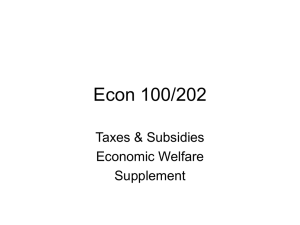Case Study Argos and Littlewoods Price Fixing Arrangement
advertisement

Case Study Argos and Littlewoods Price Fixing Arrangement PRELIMINARY TEACHING NOTE CASE SYNOPSIS This case illustrates the welfare consequences arising from collusive conduct as captured through the actions of two dominant UK high street catalogue retailers, Argos Limited and Littlewoods Limited, in conjunction with Hasbro Limited. The price-fixing agreement is estimated to have taken place within the UK toy market during the 1999-2001 period and involved fixing the price of a selection of Hasbro products to their recommended retail price (RRP). PURPOSE The case is designed for the discussion of the motivation towards and consequences of price-fixing initiatives. Students are expected to recognise the special conditions created by imperfect competition such oligopolistic and monopoly that facilitate anti-competitive conduct. In particular this case provides students with a real-life illustration of the interdependent dynamics of their relationship and enables comparison with the counterfactual and elaboration of the inherent welfare consequences. The case can also be used to examine regulatory issues, from both the government perspective and the impact on firms. The government has a vested interest in moving economic activity towards a generally more competitive context but is constrained by limited information. Moreover, small firms hailed as significant contributors to productivity are confronted by costly regulatory requirements. Students, particularly postgraduate business students can also use the case to examine firm strategic decision-making and the extent to which unethical behaviour may also be considered an option. Global firms operate within an increasingly competitive environment dominated by a few big players and face increasing pressure from share holders to deliver yet greater profitability. BASIC PRINCIPLES/CONCEPTS Oligopolistic market structures and interdependence considerations (vs. the Competitive alternative). Game theory application. Collusive practices broadly and price fixing specifically Welfare concepts (Pareto optimality), Deadweight loss; Efficiency constraints. Second best solution. Information asymmetry 1 TEACHING METHODS The case is written primarily for advanced/intermediate (second/third year) economics majors but could also be used on an introductory economics programme of a postgraduate course. It is expected that students would already have covered/been introduced to the range of market structures (perfect competition through to monopoly) and students would be able to compare and contrast the different efficiency/welfare outcomes associated with each market structure. The case is designed to be discussed in one class session of approximately one and a half to two hours duration. Dependent on the class background a varying mix of the end of case questions can be used, it is not anticipated that necessarily all questions will be used during one session. For example, economics majors would benefit from the earlier selection of questions, 1-2 and 4 founded on knowledge of more complex economic concepts, (oligopolistic equilibrium diagrams; pareto optimality, etc) while business students will have a greater interest in incentives and the problems of regulation, questions 4 and 5. Three questions should be sufficient for the session based on small groups reporting back during a plenary session. The case questions have been devised to accurately reflect the divergent economic competence of the two groups such that advanced economic undergraduate students would be able to incorporate knowledge of Bertrand/Cournot oligopolistic models and develop further on welfare consequences beyond the acknowledgement of price/output to include deadweight loss and pareto optimal concepts. The case provides students with the opportunity to develop their analytical skills with respect to the application of theoretical economic concepts and to the consideration of regulatory issues. 2 TEACHING GUIDE SUMMARY Concepts: Learning points: 1. Oligopolistic market structures. 2. Collusive v. Non-Collusive conduct 3. Welfare consequences of pricefixing 4. Economic regulation Industry dominance by a small number of large firms Interdependence constraint on behaviour. Barriers to entry and abnormal profits Kinked demand curve* Cournot and Bertrand duopoly analysis* Explanation of Nash equilibrium* Game theory strategic analysis Prisoner’s dilemma Collusion and risk avoidance* Information asymmetry and cheating within agreement* Unfair competition, demand = supply equilibrium undermined Potentially higher prices and less choice. Divergence from pareto optimal outcome.* Distributional concerns, shifting of consumer surplus to producer surplus* Explanation of deadweight loss. Information asymmetry and the difficulties of regulation. Problems of over/under regulation and the business consequences, e.g. disincentive effects, small business increased costs. Explanation of regulatory capture. Intermediate/advanced undergraduate economics students’ responses to incorporate knowledge of these concepts. 3











